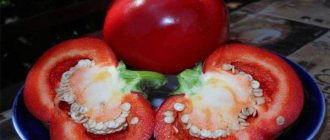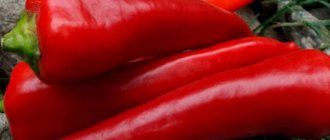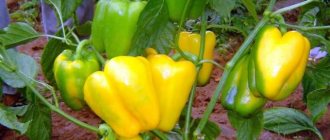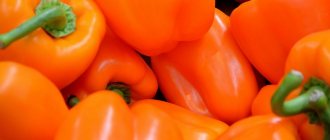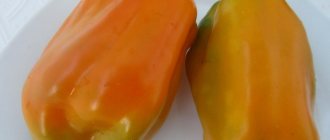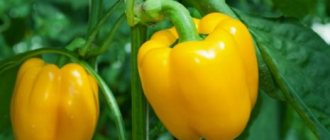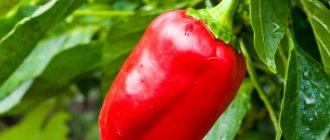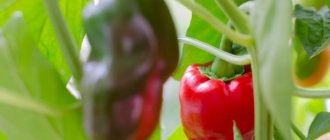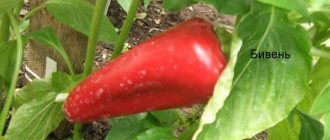There are quite a lot of pepper varieties today, but summer residents have always singled out the “Big Mama” variety as one of the best (photo 1). It has many advantages over other peppers, so gardeners often choose it. What are the strengths of this species and why is it so attractive?
The characteristics of the “Big Mama” variety and its productivity exceed literally all the expectations of gardeners; reviews about it create the impression that this species has no shortcomings that could compromise itself in front of its competitors.
What type of pepper is this?
The variety is new, developed quite recently, first registered in 2012 . The very word “Big” (large) already gives a certain characteristic to the variety. Big Mama fruits are bright orange in color and rich in beta-carotene, which determines the color of the vegetable.
Reference! Most people believe that orange peppers are the sweetest, although this is a misconception. However, orange color has a beneficial effect on a person’s psychological mood.
Characteristics and description of the variety
Big Mama is a variety with early fruit ripening . About 140 days pass from the appearance of the first shoots to full ripening. Designed for cultivation in open ground and in greenhouses. Has excellent taste.
Semi-spreading bushes with a height of 50 to 70 cm , in greenhouse conditions can reach 1 m. The leaves are medium-sized, smooth, dark green in color. The root system is powerful. The stems are strong, but during the fruiting period they require additional support in the form of a garter. The variety is resistant to many diseases of the nightshade family and is rarely attacked by pests.
Important! Outdoors, Big Mama is grown only in the southern regions of Russia.
Distinctive features
Big Mama peppers are grown using the traditional seedling method . Plants require additional feeding; regular watering with warm water and loosening the soil is important. It tolerates low temperatures well and is able to quickly recover from cold shock.
Fruit ripening lasts from August to September. In unfavorable weather conditions, peppers can ripen at home.
The photo shows the fruits of the Big Mama sweet pepper.
Fruit characteristics and yield
The fruits are large, cube-shaped . Average weight is about 120–150 g, maximum weight is 200 g. The surface of the skin is smooth, glossy, with slight ribbing on the sides. The pulp is fleshy and juicy, ranging from 6 to 12 mm thick.
The color of ripe peppers is bright orange, and during the period of technical maturity it is green. The fruits are suitable for both fresh storage and freezing. Universal use: fresh consumption, preservation, cooking.
Seed germination rate is about 80% . Productivity is high: about 7 kg of fruits per 1 sq. m. Big Mama is not inferior in yield to the famous variety Californian Miracle and is far superior to another popular variety Belozerka.
Attention! Orange peppers are not the sweetest. They are inferior in sweetness to red peppers. But fruits of orange and yellow colors are especially rich, compared to peppers of other colors, in vitamin P, potassium, phosphorus, iron and rutin - a substance that strengthens the walls of blood vessels.
Description and characteristics of the variety. Sweet large-fruited pepper - fat man: "Big Mama"
Harvesting and beneficial use of crops
Harvesting of Big Mama peppers begins in late August - early September. You can start picking already during the period of technical maturity, when the fruits have grown but still retain their green color. If the harvest is harvested at this time, a new wave of fruit formation will soon begin. As a result, you can harvest up to 3 times from each bush.
Big Mama pepper can be stored for a long time without losing its commercial quality. It is juicy and sweet, perfect for fresh consumption (salads), in first and second courses (borscht, stew), and in canning.
This vegetable is rich in vitamins (A, E, C, group B) and minerals (potassium, phosphorus, fluorine, iron, zinc), and therefore is very beneficial for the body.
Big Mama sweet peppers are tasty, beautiful, healthy and easy to care for. Having appeared on farmland less than 10 years ago, it has already won the love of vegetable growers. The rules for caring for the variety are not very different from the general recommendations for growing sweet peppers. The high yield and large size of the fruits justify all the efforts spent on growing Big Mama.
Preparation for cultivation
Varietal pepper Big Mama requires preliminary preparation for cultivation :
- First, the seeds are soaked for several hours in plain water. It is best to use melt water (melted snow).
- Then they are placed in a growth stimulator. Suitable solutions include aloe juice, infusion of onion peels and ash, and honey water. You can also use store-bought products: “Novopin”, “Zircon”, “Epin”, “Immunocytophyte” and others.
- A few hours after soaking, the seeds are removed from the solution and dried before planting.
Sowing is done in February (if planting is planned in a greenhouse) and in early March (when planting in open ground). Seedlings require special soil designed for planting tomatoes and peppers. Vermicompost, coconut extract and fertilizer (for example, Shungi Terra) are added to the soil. After seed germination, after 8–10 days, the shoots are placed in special containers for further growth.
Reference! Soaking seeds increases the percentage of germination and ensures uniform germination.
Landing
Big Mama peppers are grown traditionally - through seedlings. Before sowing, seeds are disinfected with peroxide, potassium permanganate or Fitosporin. Soak for 2–4 days: spread the seed material in damp gauze.
To stimulate germination, activators are used:
- Novosil;
- Phytospectrum;
- Immunocytophyte;
- Zircon.
Among natural remedies, an infusion of aloe or ash is effective.
When to plant seedlings for early harvest? Seeds are sown from the 2nd–3rd decade of February and throughout March. The soil mixture is prepared from peat, sand, turf, and compost. Suitable containers include pots and cups with a volume of 300–400 ml and dimensions of 10 by 10 cm.
The seedlings are fed with Aelita Vegetable, which makes the bushes grow as strong as possible.
Water the seedlings with settled water. Transplanted to a permanent place at 60–65 days of age. For 1 sq. m place 3-4 vegetables.
Growing seedlings
To ensure that the seedlings are suitable for further planting, follow a few simple rules :
- Seedlings are prepared approximately 3 months before the expected date of planting in the garden.
- Containers with seedlings are covered with plastic film in order to maintain a certain microclimate and maintain moisture levels.
- Water regularly: 2-3 times a week.
- Young shoots will need 12 hours of light - use additional light sources.
- Regardless of the further method of cultivation (in a greenhouse or in open ground), the seedlings must be planted in soil heated to at least +15 °C.
- Before planting in the ground, hardening is necessary. Over 1-2 weeks, the air temperature is reduced at night to +12–14 °C. 3-5 days before planting, the temperature should be consistent with outdoor conditions. To do this, the seedlings are taken out onto a glassed-in balcony and left there for the remaining time.
Attention! The amount of moisture required depends on the temperature. The warmer the room where the seedlings are grown, the more water they need.
Seedlings can be grown in two ways:
- With picking: the seeds are sown in a common box, then the sprouts are transplanted into separate cups.
- Without picking - directly into separate containers with a volume of 300 to 350 ml.
It is better to cultivate peppers without picking , since after planting the seedlings noticeably slow down their growth, sometimes stopping for 1-2 weeks. This is due to the increased sensitivity of the fragile roots of the vegetable to any, even the most insignificant, mechanical impact.
If you choose the picking method, keep in mind : the older the plant, the easier it is to replant it without damaging the root system. Before removing the sprout from the ground, water it well - this will make it easier to get the seedlings. Make small holes in the cups at the bottom and sides of the bottom. Replant the plant carefully, without bending the root. It must be planted at the same depth at which the seedling grew.
Planting pepper
Seedlings are planted in the garden from the moment the first flowers appear . If the temperature does not yet meet optimal levels (below 15 ° C), a temporary shelter is built. Peppers are planted according to a 35x50 cm pattern or a little looser. Burying seedlings is excluded. It is recommended to mulch the soil using a thin layer of humus or peat chips.
Reference! Mulching the soil will help combat possible drying out of the soil and weeds.
Further care
Big Mama pepper is especially moisture-loving . The soil should be moderately moist at all times.
Feeding the plant is mandatory : the first time 10–12 days after planting the seedlings, the second time immediately after mass flowering. The peppers are fertilized a third time after the appearance of the first fruit, which acquires an orange color. Use mineral or organic fertilizers, but do not overdo it with nitrogen.
The bushes do not require special shaping . You just need to remove those branches that have grown below the first fork.
Timely weeding helps accelerate the development of the plant. This is also good prevention against pests.
Fruits can be harvested at a state of technical maturity. They, just like orange peppers, are tasty and healthy. This makes it easier for the next peppers to grow.
Reference! An excess of nitrogen can provoke active growth of the plant, prompting it to produce new shoots, but there will not be a high yield.
Growing and care
For medium-sized bushes, shaping is an important procedure that increases productivity. Rules:
- pinch 1 bud;
- at the branching, remove all the brushes with ovaries and flowers;
- leave 2 main stems;
- At the end of the season, the growing points on the shoots are pinched (so that the formed fruits ripen).
After watering, the beds are loosened; the surface can be mulched with a layer of 8–10 cm. Fertilizers are applied once every 2 weeks.
Features of growing the variety and possible difficulties
peppers are suitable for growing in any climatic conditions . The period for planting seedlings largely depends on the region where the planting takes place.
Attention! You cannot plant peppers in an area where nightshades previously grew, as they deplete the soil, taking away almost all the microelements necessary for pepper growth.
During the entire growing season, the bushes must be tied up . Removing the first stepsons and buds will increase the yield.
Despite the fact that growing Big Mama is no more difficult than any other variety of pepper, if not properly cared for, you can encounter certain difficulties (see table below).
| Problem | Possible reason | Solution |
| Pepper does not produce buds for a long time | The nitrogen content in the fertilizer is exceeded. Use of manure. | Use a fertilizer with low nitrogen content. Do not use manure fertilizer. |
| The pepper is blooming, but there are no ovaries | High humidity in the greenhouse. The air temperature is too high. Severe and sharp cold snap (below +12 °C). | Spray the bushes with a special solution in the daytime (Bud or Ovary preparations are suitable). Ventilate greenhouses in hot weather. Heat greenhouses during prolonged and severe cold spells. Reduce watering. |
| Flowers or ovaries fall off | The plant suffered a frost. Excess nitrogen in the soil. Soil drying out. A sharp difference in night and day temperatures (more than 15 ° C). Prolonged cold snap. Watering with cold water. The plant was exposed to a disease: fruit rot. | Spray the pepper leaves in the evening with Uniflor Bud fertilizer. |
| The stem is rotting | Stem rot caused by poor ventilation (if peppers grow in a greenhouse) and high air humidity. | Stop watering when the first signs of disease (white plaque) are detected. Ventilate the greenhouse regularly. Remove all leaves and stem shoots up to the fork. Thin out the stems of each bush. Remove plaque by treating the affected area with a strong solution of potassium permanganate. |
| A light spot has formed on the top or side of the fruit | Top rot caused by a lack of potassium, calcium, and water. | Water. Feed with potassium and calcium. |
| The leaves curl or rise up and have a brown edge. | Lack of potassium and phosphorus. | Use Uniflor Bud fertilizer. Feed with superphosphate. |
| The leaves have brightened | Lack of nitrogen. | Feed the plant with weed infusion, diluting it with water in a ratio of 1:5. |
Purple peppers: features and benefits
Deep purple peppers are colored this way due to the pigment anthocyanin. In addition to the bright and unusual surface, the crop acquires resistance to cold weather and long growing seasons.
Benefits of anthocyanin
Anthocyanin in the pulp of the Big Papa variety has a beneficial effect on the body:
- helps destroy bacteria;
- prevents colds and viral infections;
- strengthens blood vessels, improves the functions of the visual organs;
- normalizes blood pressure.
Purple peppers are a source of vitamin that strengthens the immune system and improves vision functions.
What you need to know about fruits?
The main advantage of the variety is its unusual purple fruits, which change color during the growing season or during heat treatment. At the stage of technical maturity, vegetables have a dark red color, and upon reaching biological maturity they turn purple. During long-term storage and heat treatment, the fruits turn brown. To surprise guests and family members with unusual vegetables, you can pickle them, freeze them, cut them into cubes or strips.
Advantages of the variety
Agrotechnical characteristics of the Big Papa pepper will help gardeners consider its advantages:
- dense walls 5-8 mm thick;
- sufficient fruit weight - up to 100 g;
- high stable yield - in closed soil conditions, up to 6 kg are harvested per square meter;
- disease resistance;
- juiciness and aroma of fruits, which are not lost after heat treatment.
The crop can be grown in the southern regions without shelter. In the middle zone, the plant is planted only under film, sowing seeds in February-March. Peppers are picked at the 1-leaf stage and transferred to the ground in May or June. Seedlings are planted at a distance of 50 cm from each other, keeping row spacing of 35 cm. Trellis are organized for gartering tall bushes. The harvest can be harvested from July to September.
Typical diseases and pests
The table shows the most common diseases and pests of peppers , as well as ways to combat them.
| Diseases and pests | Signs | Ways to fight |
| Fruit rot at the point of attachment of the fruit. | The ovaries fall off. | Spray the pepper leaves with Uniflor Bud in the evening. |
| Stem rot caused by poor ventilation | White coating on stems and leaves. | Stop watering temporarily. Ventilate the greenhouse regularly. Remove all leaves and stem shoots up to the fork. Thin out the stems of each bush. Remove plaque by treating the affected area with a strong solution of potassium permanganate. |
| Spider mite | Bronze or white color on leaves. | Spray the damaged areas of the plant with Malathion. Water with dandelion infusion. |
| Aphid | Pests are visible to the naked eye on the underside of leaves. | Water with tobacco solution in the morning. Water with dandelion infusion. |
| Slugs | Large holes on the leaves. | Place grains of “Groza” or “Meta” preparations near the stems and tie the lower stems with nettles. Pour the peppers with a 9% vinegar solution diluted in water (0.5 tbsp vinegar per 5 liters of water). Be sure to sprinkle the soil with ash to prevent acidification. Remove slugs mechanically (collect by hand). |
Growing in Russia
“Big Daddy” is suitable for the middle zone (East of Russia - East European Plain), as well as the Volga region, where temperature conditions are more favorable. In the North, including in areas with cool summers (with temperatures of 15-20 degrees), it is necessary to use Utrasil or other film to maintain heat. It is better to place the culture in a greenhouse. In the Volga region, especially in areas with chernozem soils, pepper grows best. It does not require additional shelters.
However, during the summer in southern areas, daylight hours are shortened, so additional lighting may be required (to maintain light for 12 hours).
In Kaliningrad, Sevastopol, and other areas with hot summers, it is necessary to provide protection against leaf burns. To prevent the leaves from withering due to constant exposure to ultraviolet radiation, it is recommended to install shading or plant the crop where the sun does not shine directly all day. You should not moisten the plant during the heat with a large stream of water: this can not only lead to breakage of the stem, but will also intensify the burn. Large drops act like a prism and enhance the effect of the sun.
Since the clay soils of the middle zone are not nutritious enough for sweet peppers, when planting in open ground, it is necessary to fertilize them. If the clay soil spreads too much during the wet period, add a third of sand; and it is recommended to add chernozem or brown soil to sandy soil - the result of leaf humus.
“Big Papa” is a common farm crop, which indicates its high yield in Russian conditions. However, for good yields, you must follow all the rules of agricultural technology.
Advantages and disadvantages of the variety
The variety has no significant disadvantages . In rare cases, the plant does not take root or does not bear fruit. Most often, such problems are caused by errors in care or other reasons listed in the table above.
The Big Mama variety has plenty of positive qualities.:
- excellent taste;
- beautiful appearance of the fruit;
- high seed germination;
- high productivity;
- good survival rate of young plants;
- relative ease of cultivation;
- unpretentiousness;
- cold resistance;
- immunity to disease;
- high content of vitamins and minerals (vitamin C, P, carotene, phosphorus, potassium, calcium, iron, etc.).
Diseases and pests
The Big Mama variety is quite resistant to many diseases. However, if the care rules are not followed (stagnation of water, excessive humidity), the pepper can suffer from late blight and rot.
We advise you to find out whether you need to chop bell peppers.
Spraying plants with garlic infusion, which is prepared from 100 g of garlic diluted in a bucket of water, is effective against late blight.
Peppers are also susceptible to attack by pests such as spider mites, aphids, and slugs . To get rid of them, you need to sprinkle the soil under the bushes with ground pepper or dry mustard, and spray the plants themselves with a solution of succinic acid.
The remedy is effective against ticks. And for aphids you can prepare a tobacco infusion (300 g of tobacco crumbs, infused for three days in 10 liters of water).
However, you should not start treating plants prematurely. All therapeutic measures must be carried out after damage is discovered on the bushes.
To prevent diseases and pest attacks, it is recommended to prevent the beds from becoming waterlogged, regularly ventilate the greenhouse, and adhere to all growing rules.
Did you know? Chocolate and sweet peppers have something in common: both provoke the release of endorphin, the hormone of happiness, into the blood. The effect of both products is the same, but sweet peppers do not harm your figure.
Reviews
Most reviews about the Big Mama variety are positive . People note its good yield, unpretentiousness, early ripening, excellent taste and attractive bright orange color.
Olga, Kaluga : “I really liked the variety, I’ve been growing it for two years now. I planted it in a garden bed, not in a greenhouse, and at the end of July the first orange fruits appeared. All other peppers ripened a little later, around mid-August. Advantages: unpretentious, does not require special care. It grew in rather poor soil, but the harvest was good.”
Evgenia, Saransk : “I immediately liked this variety of pepper for its appearance on the bags. The seeds were very inexpensive. Shoots appeared quickly. Of the three varieties planted at the same time, Big Mama sprouted the earliest - on the eighth day. It also developed quite quickly. After three months, beautiful little peppers formed. Already in August they all ripened and became a rich orange color.”
Oleg, Krasnoyarsk : “Orange peppers were grown for the first time, previously only red ones. We bought Big Mom seeds because we liked the description on the package. The reviews are also good. They planted it in a greenhouse. There were a lot of fruits, large, cube-shaped. Very sweet and juicy. I'm pleased with the variety. I paid a little more attention to it because it is new to me. The fruits are great for stuffing.”
Growing
California miracle pepper can be planted in greenhouse conditions and open ground. The yield in greenhouses is higher, but if you plant it in the garden, you can achieve good results. In greenhouses, crops are mainly grown in risky farming zones, which include Siberia, Transbaikalia, and the Leningrad region.
Depending on the growing conditions, the technical maturity of the fruit occurs 110–130 days after the appearance of the first shoots. It will take another 15-20 days for them to turn red.
Seed preparation
California miracle is a varietal species, not a hybrid, so you can collect pepper seeds yourself for sowing next year. To do this, the peppers are brought to full maturity and the largest and best are selected. Seeds from such fruits demonstrate good germination - 96%. However, they do not need to be pre-soaked in a growth stimulator. They germinate well naturally.
However, gardeners advise sowing seeds for seedlings no older than 1-2 years. If the seed is stored longer, its germination rate deteriorates and decreases to 75%.
Sowing
Seeds for seedlings for planting in a greenhouse are sown at the end of February. For open ground - 2-3 weeks later.
Sowing consists of several stages:
- For seedlings, a soil mixture is prepared based on humus (3 parts), garden soil (3 parts) and sand (1 part). Wood ash is added at the rate of 1 cup per bucket of prepared soil.
- The seed material is soaked in a solution of potassium permanganate for half an hour. Then dry it on a cloth.
- Each seed is buried 1-1.5 cm into the ground. Or the seeds are laid out at a distance of about 2.5-3 cm from each other, covered with earth and lightly compacted. The next stage is watering. To moisten, you can use a small watering can with a nozzle or a spray bottle.
- The box is covered with film or glass. During the first few days, sunlight is not as important as warmth. After 2 days, the film is removed for ventilation. This is necessary so that the surface of the earth does not become covered with mold. After the sprouts appear, the film is completely removed and the boxes are placed in a well-lit place.
With the appearance of shoots, pepper needs light, preferably at least 12 hours. There is not enough daylight in the spring, so artificial lighting is provided.
As the soil dries, the seedlings are watered with a watering can so as not to damage the stems.
Picking
After the appearance of 2-3 main leaves, the seedlings dive
When replanting peppers, it is important not to bury the bushes, but to plant them at the same depth. It is better to pre-sow the seeds infrequently so that the seedling can be replanted with a lump of earth
An important stage of growing is hardening of seedlings. With the onset of warm, sunny days, the seedlings are transferred to the balcony, veranda or outside. First for half an hour, then gradually increasing the time until a full day.
Transplanting seedlings into open ground
For peppers, it is important that the soil is heated by the sun. In cold soil, seedlings take longer to take root and become sick
The California miracle is planted in the ground 55-60 days after germination.
Sweet pepper “Big Boy” - characteristics of the variety
Pepper "Big Boy" attracts with its original appearance. Ripe cylindrical fruits are practically a “decoration” of any garden plot.
The weight of a mature “Big Boy” can reach up to 300 grams, and the wall thickness of the pepper can be up to 0.8 cm.
“Big Boy” pepper has a mild and pleasant taste, does not give off bitterness, which allows it to be used for any culinary purposes - from preparing light summer salads, to stuffing peppers with various fillings and preserving them in the form of aromatic lecho.
The bush of the crop has a semi-spreading shape that grows to an average height. The leaves are slightly wrinkled in structure and not too large in size.
With proper care of the “Big Boy” - providing timely feeding for the plant, using high-quality mineral fertilizers and establishing the correct watering regime - you can get a harvest weighing up to 7.5 kg per square meter of land. And the optimal size of the fruits makes it easy to organize the process of transporting and storing vegetables.
Big Mama pepper: reviews, photos, yield
There are quite a lot of pepper varieties today, but summer residents have always singled out the “Big Mama” variety as one of the best (photo 1). It has many advantages over other peppers, so gardeners often choose it. What are the strengths of this species and why is it so attractive?
The characteristics of the “Big Mama” variety and its productivity exceed literally all the expectations of gardeners; reviews about it create the impression that this species has no shortcomings that could compromise itself in front of its competitors.
Characteristics of the Big Mama pepper
As is customary for gardeners, they begin to plant seedlings several months before the summer season. The time for planting each type is individual, for example, cabbage is planted in mid-February, and chrysanthemums are usually not earlier than April.
Similarly, like cabbage, “Big Mama” peppers are planted in mid-to-late February, however, the pepper needs to create the most favorable conditions for subsequent good fruiting.
First of all, it is important to provide the pepper with as much light as possible, this will help speed up the appearance of the first shoots.
For this reason, many gardeners believe that it is best to plant peppers in March, when there will be enough sunlight for favorable pepper growth, and there will be no need to create artificial lighting.
However, this species belongs to those varieties that ripen and grow early. Therefore, experienced gardeners say that February is not the best time to plant Big Mama peppers. It is necessary to plant this species, preferably at the end of January, since the harvest will then appear much faster. And this aspect is decisive for many gardeners.
Gardeners claim that by allowing Big Mama peppers to grow on their plots, they end up with fairly large, bright orange, rectangular fruits. They are smooth to the touch and have no prominent ribs.
Their weight is up to 200 g.
The ripening period of “Big Mama” is two to three months, so after planting very soon you will be able to serve delicious peppers on your table as a salad component or a whole fruit stuffed with various fillings.
Gardeners quite often praise not only the size of the Big Mama pepper, but also its taste. This variety tastes very sweet and quite juicy. Gardeners often use this species for various purposes. They claim that it is universal and can be suitable not only as a culinary ingredient, but also for subsequent preservation.
Thus, the main advantages of Big Mama pepper include the following:
- excellent taste and tender pulp;
- high ripening speed;
- high productivity;
- large fruits;
- The plant is unpretentious to the conditions of maintenance and care.
Growing and caring for Big Mama peppers
This variety is not picky regarding climatic conditions and can be grown in places with any weather conditions. This pepper can thrive both in a greenhouse and in open ground. “Big Mama” seeds should be prepared very early, in early March, since rapid ripening is supported by their careful processing.
However, their height is not very large, it is only 80%, for this reason additional processing actions in relation to the seeds will not interfere, but will only help stimulate good growth.
To do this, you need to place the seeds in an infusion of potassium permanganate for about 15-20 minutes, after which you can soak them in aloe juice, but this procedure is not necessary, although no less useful.
Such manipulations will enrich your seeds with additional strength and speed up the appearance of the first shoots.
During the process of growing seedlings, your pepper will need constant feeding, but it is worth using a comprehensive option.
For example, if you plan to plant your seeds in early March, then it will be extremely necessary for them to be provided with adequate light supply.
That is, your seeds should be kept in a well-lit room for 12 hours a day. For this purpose, you can purchase specialized lamps that simulate sunlight.
However, as soon as the height of the first shoots reaches 20 cm, it is necessary to immediately stop providing the plant with light. At this point, the sprouts already need natural light, so move them out of the room to where they can feed on it.
“Big Mama” peppers are planted in open ground 75 days after planting. Approximately this should happen at the end of May or beginning of June. This aspect directly depends on the climatic conditions of your region. This variety of pepper needs loose soil; you should give special preference to loam.
It is worth recalling that the fruits of the Big Mama pepper are quite large, therefore, as soon as the plant size reaches half a meter or more, this species will seriously need additional supports and garters. In addition, add nutrients to the soil to get a rich harvest. This is especially true for those fruits that are visually larger than all the others.
It is also necessary to systematically feed the plant. This should be done three times: almost immediately after planting, during the period of active plant growth, and also during the period of dynamic fruit ripening. To water the Big Mama pepper, use warm water, it should be moderate. Make sure that the soil under the plant remains loose and free of weeds.
It should be noted that additional feeding of the plant with mineral fertilizers is important, since this type of pepper has large fruits. Professional gardeners claim that the best solution for this would be fertilizer complexes specially created for this purpose. They will provide your pepper with all the nutrients it needs.
There is also a hybrid variety of this pepper, which is called “Big Mama F1”. It is somewhat different from the usual "Big Mama" look as it is of South Korean origin.
It is grown mainly in agro-industrial areas. Its taste is in stark contrast to the regular Big Mama. Big Mama F1 is often spicy, with just a hint of sweetness.
Therefore, before purchasing, carefully check whether you are buying the right pepper seeds.
Reviews from gardeners and gardeners about the Big Mama pepper
Many gardeners often admire how the Big Mama pepper manages to surprise them. Here are a few real reviews from people who have planted this species more than once.
Ivan Karlovich, 67 years old. Kostroma.
“I believe that this variety (“Big Mama”) is a real discovery for many gardeners! I have been looking for quite a long time for exactly the type of pepper that will suit me in all respects.
And it was “Big Mom” that turned out to be the most acceptable for me! I didn’t like the fact that many peppers either didn’t ripen, or the climate in which I grew them didn’t suit them, or I simply didn’t like the taste of peppers.
I thought that there was no longer a pepper that I would be happy to grow, but my neighbor once came to visit and boasted about the “Big Mama” pepper, which she had been growing for several years at her summer cottage.
I tried it and was surprised! The taste was simply amazing, and I asked her what the name of this variety was. After that, I decided to try to grow Big Mama myself. And I’m still doing it.”
Maria, 51 years old, Salsk, Rostov region.
“When I planted this pepper, after a while I was amazed at how big the bush grew! I liked, first of all, the versatility of this pepper. Now I often make sliced vegetables or salads out of it, can it, or stuff it with some interesting filling. I think they will continue in the same spirit. And my family will always be fed with a quality product.”
Nikolai Nikolaevich, 71 years old. Solnechnodolsk.
“Just recently, in the middle of last year, my wife and I decided to purchase a summer cottage. My wife has always had a passion for gardening, so I didn’t hesitate before giving an affirmative answer.
She was very worried at first, since she had never done this before, but she decided that the first thing we would plant in the garden would be peppers. Only she couldn’t decide which variety to use. Our neighbor at the dacha suggested that it is best to use Big Mom seeds. And he didn’t deceive.
We planted seeds, which sprouted very quickly. My wife immediately became interested in this activity and was constantly running around shopping for special fertilizer for these plants, or for fertilizers.
As a result, the bushes grew very tall, almost a meter in size, and the first fruits appeared literally a few months after my wife planted them in open ground. In the end, today we are enjoying juicy peppers, and my wife said that next year we will plant “Big Mama.”
Pepper Big Mama reviews photos, features of the variety
| Ripening period: | 110-112 days |
| Fruit weight: | 120-200 gr. |
| Pepper shape: | cuboid |
| Productivity per sq. m.: | 8-10 kg in protected ground, 4 kg in open beds |
Big Mama pepper appeared on the market relatively recently, but has already gained popularity among admirers of early varieties.
A representative of the nightshade family shows good productivity with proper agricultural technology and is distinguished by its excellent taste.
General description of the variety
The Big Mama pepper variety was included in the State Register of the Russian Federation in 2011, and the originator is Agro.
The average height of a semi-spreading plant is 1.5 m. In open beds without the formation of a stem, pepper does not grow more than a meter. If the bush is grown in closed structures and is formed into several stems, the plant can reach limits of 1.6-1.7 m.
The cultivar, adapted to unfavorable factors, tolerates sharp changes in day and night temperatures in spring. Even under unregulated growing conditions, Big Mama shows good fruit set and long fruiting.
Fruit characteristics
The fruits of the variety are large, cube-shaped, weighing up to 200 grams. The skin of the pepper is smooth and glossy, green in color at the stage of milky ripeness. When fully ripe, the color changes to bright orange (see photo).
The flesh of Big Mama is very juicy, fleshy, with a pronounced peppery aroma. The length of one vegetable reaches 12-13 cm with a diameter of 11 cm. The pericarp wall has a thickness of approximately 8-8.5 mm.
Peppers are intended for universal use: they can be frozen, stuffed, or added to first and second courses. The variety is not suitable for whole-fruit canning due to its impressive size.
The nutritional value of Big Mom is its high content of carotene and vitamin C.
Productivity
On one bush, without shaping, from 4 to 7 large fruits set and grow. When forming a crop with 2 or 3 stems, the number increases approximately 2 times: this agrotechnical approach allows you to get up to 12 vegetables from a bush.
When grown in a greenhouse and following all recommendations for caring for 1 sq. m. up to 10 kg of vegetables are collected. In unprotected soil the figures are more modest - 4 kg from the same area.
Features of cultivation and care
Early ripening varieties are recommended to be sown no earlier than the first ten days of March. This will avoid premature flowering of peppers, when transplanting into the ground is still far away.
One of the important procedures, according to experienced gardeners, is the removal of the crown flower at the seedling stage. It significantly reduces the yield, since the plant directs all its energy to the ovary and ripening of the first fruit.
The seedlings are moved to a permanent location at the age of 70 days. In this case, the danger of return frosts should pass. For different regions, the favorable planting period is mid-May - early June. When cultivated in a greenhouse, seedlings are usually planted in May.
Recommended planting scheme by the originator: 70 cm – row spacing and 35-40 cm between plants in a row.
According to the description of the variety, Big Mama pepper is classified as tall, which means it requires obligatory gartering to supports. For this crop, it is also recommended to form 2-3 stems to increase plant productivity.
For better air circulation and disease prevention in bushes, it is necessary to remove the lower leaves and shoots before the first fork. Such activities also help increase productivity.
Pinching the crown is not carried out, since the bush branches well even without this procedure.
Care after planting in open or closed ground comes down to traditional measures: regular watering, fertilizing, loosening and weeding. The last two procedures take a lot of time and effort, so it is recommended to mulch the bushes immediately after replanting.
The Big Mama variety is very responsive to fertilization. During the season, it is recommended to carry out 2-3 fertilizing with organic matter or mineral complexes.
Resistance to diseases and pests
The Big Mama variety is rarely susceptible to nightshade diseases. Sometimes plants can be affected by late blight. The risk of developing a fungal infection increases if crop rotation is not observed and there is a lack of preventive spraying with fungicides and ventilation of greenhouses.
To avoid or reduce the risk of developing fruit rot, peppers should not be planted after nightshades. It is also not recommended to be near vegetables of this family.
In the fall, after harvesting, greenhouses must be disinfected, and all plant residues must be burned. Spraying peppers with Fitosporin for preventive purposes will also reduce the chances of developing an infection.
Pepper is susceptible to attack by pests such as spider mites, aphids, and thrips. The bushes of the plant should be regularly inspected for the presence of parasites. At the first signs of damage, you should immediately treat with chemicals.
Advantages and disadvantages
According to gardeners, Big Mama sweet pepper has the following advantages:
- early ripeness;
- large fruit;
- thickness;
- high productivity;
- resistance to temperature changes;
- sweet taste without bitterness;
- increased content of vitamins;
- universal use in cooking.
Source: https://vegetory.ru/sad-i-ogorod/perecz-big-mama-otzyvy-foto-urozhajnost
Pepper care
The pattern for planting peppers is 50x35 cm, the holes are prepared in advance. The soil should be fertilized in the fall (organic matter - up to 5-6 kg, ash and superphosphate - 50 grams each). The standards are given per square meter.
The holes are spilled with water, and the seedlings are carefully planted with a clod of earth, immersing the cotyledon leaves into the soil.
Further care is:
- watering;
- loosening;
- fertilization;
- prevention from diseases and pests.
Watering
Sweet peppers love moisture, but cannot tolerate waterlogged soil. You need to especially carefully control watering in the greenhouse, since there, in a closed space, it is more difficult to maintain optimal humidity levels.
Peppers are watered more abundantly at the beginning of flowering, as well as at the moment the fruit begins to set. They also take into account the weather, watering the plants more often on hot days.
Loosening
Loosening is carried out after watering, preventing the appearance of an earthen crust. The roots of peppers are shallow, so it is important not to damage them when loosening. All weeds must also be removed.
Fertilizer application
When gardeners complain about low yields of sweet peppers, they need to figure out whether all the requirements for the crop’s agricultural technology have been met correctly and in full. You won’t get tasty and juicy fruits if you don’t take care of high-quality plant nutrition.
The first time sweet peppers need to be fed is approximately 21-15 days after planting the seedlings. Slurry that is diluted in water (1:10) is suitable.
The second feeding is carried out during the flowering period, the third - when fruit formation begins. For these fertilizers, compositions with a predominance of potassium and phosphorus are selected. Apply foliar feeding (about once a month), spraying the plants on the leaves.
Formation of sweet pepper bushes
Despite the fact that the Big Mama variety grows no more than 60-70 cm in open ground, its bushes need to be shaped. This will increase the yield of pepper and get full-fledged large fruits.
- The bud that forms first needs to be removed.
- Remove all flowers and ovaries at the fork of the pepper stem.
- Only two strong and powerful stems are left, the rest are removed.
- Remove all side shoots and shoots in the leaf axils.
- In August, it is recommended to pinch the growing points of the main fruit-bearing shoots on the bush.
In a greenhouse, where peppers grow taller, formation is mandatory.
IMPORTANT! The formation of sweet peppers not only increases the number of fruits, but also improves the growing conditions of plants. Removing excess shoots promotes good air ventilation in the greenhouse and minimizes the risk of various infections.
Pepper
There are quite a lot of pepper varieties today, but summer residents have always singled out the “Big Mama” variety as one of the best (photo 1). It has many advantages over other peppers, so gardeners often choose it. What are the strengths of this species and why is it so attractive?
The characteristics of the “Big Mama” variety and its productivity exceed literally all the expectations of gardeners; reviews about it create the impression that this species has no shortcomings that could compromise itself in front of its competitors.
Recommendations for growing the Big Mama variety
To obtain a good harvest, sweet peppers in most regions of Russia are grown through seedlings. They start with preparing seeds, soil mixture, and pots for seedlings.
Growing sweet pepper seedlings
Sowing dates are determined taking into account the climate of the region and plant growing conditions. Usually, the seeds of the variety are sown in February, so that at the end of May or beginning of June, seedlings can be placed in a greenhouse or in beds.
The seeds must be disinfected (using a pink solution of potassium permanganate) and soaked in a growth stimulator.
ON A NOTE! Instead of potassium permanganate, you can use a solution of boric acid (soak for two hours) or hydrogen peroxide (5-7 minutes)
It is important not to overcook the seeds. . Purchased growth stimulants (Phytospectrum, Epin and others) can be replaced with infusion of ash, aloe juice solution
After this, the seeds are soaked and then sown in pots. Pepper does not tolerate picking very well, and to avoid unnecessary stress, it is best to immediately sow it in separate containers. When sowing peppers in February, lighting is required to provide the seedlings with 10-12 hours of daylight.
Purchased growth stimulants (Phytospectrum, Epin and others) can be replaced with an infusion of ash or a solution of aloe juice. After this, the seeds are soaked and then sown in pots. Pepper does not tolerate picking very well, and to avoid unnecessary stress, it is best to immediately sow it in separate containers. When sowing peppers in February, lighting is required to provide the seedlings with 10-12 hours of daylight.
Pots with seedlings are placed in sunny places, ideally on south-facing window sills. The temperature should be in the range of +23°...+25° C, at night - up to +18° C. Water the plants with warm water (tap water must be left to settle). After watering, the soil is loosened, providing the root system with good access to oxygen. To strengthen seedlings and increase their immunity to diseases, they can be sprayed with simple herbal infusions - calendula, garlic, marigold.
For fertilizing (it will be enough to fertilize the plants twice), use a complex fertilizer (Kemira, Aelita vegetable), diluted mullein and poultry droppings are also suitable.
What problems can a gardener have when growing seedlings?
- With excessive watering, peppers can be affected by blackleg. The plant stalk in the lower part is depleted, the bush withers and lies down. It’s easy to avoid this - control watering and prevent the soil from becoming waterlogged. You can sprinkle calcined river sand onto the surface of the soil in a pot.
- Slow seedling growth, weak plants. Peppers urgently need nitrogen fertilizing, but here too it is very important to follow the norm!
Big Mama seedlings ready for planting should have 6-10 well-developed leaves, the plant height should be up to 15 cm.
You can plant sweet peppers when the soil warms up to +14°...+16° C. In many regions, cold snaps are likely at the end of May or beginning of June, so it is recommended to cover the seedlings on the beds with non-woven material.
Reviews about the variety
I definitely won’t say anything bad about this variety. It grows tasty, sweet, juicy. Does pepper really need anything else? Almost unpretentious in the growing process. It is important to carefully prepare the seeds before planting in a container, because... The yield is, however, not the best. But, again, with proper preparation, everything will go perfectly. And, in the end, everything comes with experience.
My wife and I planted them according to the instructions, and around the end of July we received orange peppers. The taste did not disappoint either; they are truly at their best: as they say - juicy, ripe. We haven’t changed this variety for a couple of years now, but we haven’t forgotten about others either. We like to diversify our diet, so to speak. Undoubtedly, Big Mama will become a favorite among both novice gardeners and experienced agronomists. A very worthy variety.
Description of the variety
A rather unusual variety of pepper. Belongs to early ripening. Big Mama is one of the representatives of the Big family (Big Girl/Boy/Dad). Compared to all other varieties of the group, it is considered one of the most popular.
The bushes of the plant are semi-spreading, usually reaching 0.5-0.7 m in height. If the crop is grown in greenhouse conditions, the bushes can reach 1 m in height. The fruits ripen quite large (sometimes reaching a weight of 200 g) and have a rectangular shape. The peel of ripe fruits is bright orange (during the ripening period the pepper turns green).
The surface of the fruit is smooth, the peel is quite dense and thick. The pulp is very juicy and fleshy. This variety has an ideal taste, so feel free to eat it fresh; it is also very good as a component for many dishes and canned food.
16 excellent varieties of plums for the Moscow region
The main advantages of the variety include:
- excellent taste;
- precocity;
- a bountiful harvest;
- large fruit;
- unpretentiousness to growing conditions and care.
